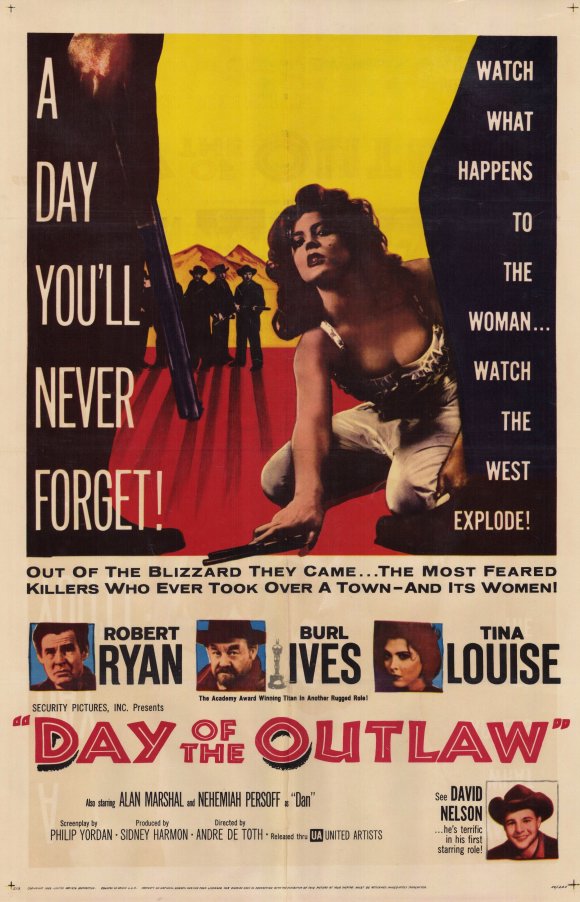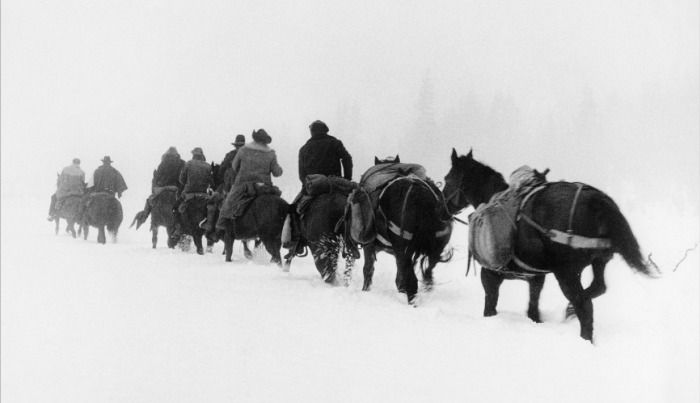Leo and Brad star
In make-believe retelling
From Tarantino
Tag / Quentin Tarantino

Film review – Day of the Outlaw (Andre De Toth, 1959)
Andre de Toth’s unusually complex Western ‘Day of the Outlaw’ has found its way onto the Master of Cinema label this month as a dual-format release. A forgotten and under-appreciated film, shining the spotlight on it will hopefully mean it finds a much-deserved wider audience.
The film is set in an isolated town called Bitter in Wyoming. The story opens with a couple of men on horses riding towards the camera in a frosty snow storm. It is a clever opening scene by De Toth, setting up the rugged main character Blaise Starrett (Robert Ryan) with the ominous line, “I’m through with being reasonable.” We know he’s got a bone to pick with someone, with the assumption that we’re going to find out who and why pretty quickly. That we do.
What is essentially a boundry dispute about the location of a barbed wire fence reveals a hidden layer of complication when we learn that Blaise is having an affair with Helen Crane (Tina Louise), wife to Hal (Alan Marshal) of said boundry dispute. She seems absolutely loyal to her husband despite evidently being in love with Blaise.
As tensions continue to rise, the two men end up in a standoff that will likely lead to one or both being killed. This is poleaxed by the arrival of an out-of-town gang headed up by Jack Bruhn (Burl Ives), who pose a much greater threat to the men, their wives, their land and their livelihood.

At 92 minutes long and a reported budget of just $400,000 (a little over $3m in 2016), De Toth has to work with what he has and work fast. It’s a great achievement that this was done so well, especially in what appears to be torrid weather conditions. Characters are fully realised despite often not being afforded enough screen time to develop them. A good example of this is young gang member Gene (David Nelson), who goes through an internal psychological journey in what amounts to about 10 minutes of screen time.
The film was cited by Quentin Tarantino as a reference point in the run up to The Hateful Eight and it’s easy to see the resemblance [1]. The opening sequence was a direct homage to Day of the Outlaw, with a long shot allowing the lead character(s) to naturally approach through a snow storm to join the viewer at the front of the screen. The secluded setting in increasingly worse weather, high tensions, conflicting characters having to live side-by-side whilst the story unfolds. Nothing is stolen, but it is clearly a film Tarantino rates.
Ryan’s Blaise makes a fantastic focal point around which the film plays out. He is a man who stands by his own morals. His affair with Helen is justified by him essentially saying he has no respect for her husband and thinks she deserves better. He undertakes an openly noble act of self-sacrifice for the good of the townspeople he thinks little of, though refuses to take any credit for it. He is the film’s only hero and he plays it coolly throughout. It isn’t Ryan’s most celebrated role but one worthy of a second look if you’re a fan.
Day of the Outlaw may be a flawed film but there’s enough on offer for fans of the anti-Western subgenre that seems to have found its way back to popular interest following the likes of Django Unchained, The Hateful Eight and The Revenant. If you liked any of these films then this is worth checking out.
[1] In an interview with Entertainment Weekly, Tarantino stated, “I can definitely say that as bleak as our movie is, we are definitely the funniest snow Western ever made. This is funnier than The Great Silence, it’s funnier than Day of the Outlaw.” Quite what he means by this isn’t exactly clear. There isn’t much humour in Day of the Outlaw.

Film review – The Hateful Eight – 70mm Ultra Panavision Presentation (Quentin Tarantino, 2015)
Tarantino and controversy seem to go hand in hand these days. Django Unchained, his last release, was shrouded in negative press. Firstly there was criticism for over-use of racial slurs in the film. This led to a range of action figures being pulled from shelves (now worth a small fortune if you have any). Then he “shut down” an interview with Krishnan Guru-Murthy on Channel 4 News when he was questioned about overuse of violence in his films (see below).
The Hateful Eight has been just as rocky in the run up to release. Firstly, he pulled the film because the script was leaked, an act that Tarantino described as a “personal betrayal”, publicly naming either Bruce Dern, Tim Roth or Michael Masden as the perpetrators. There was some “brouhaha” (his word not mine) involving the American police forces that have led several states’ police forces to boycott the film. More recently, several UK-based cinema chains – Cineworld, Picturehouse and Curzon – have announced they won’t carry Tarantino’s eighth film due to the distributors Entertainment opting for Odeon as the exclusive screener of the 70mm extended roadshow version of the film.
Now, whether this is the definitive version of the film will remain open for debate. Tarantino is saying this is the case, so as such the hardcore fans of his films are keen to see this hard-to-find version. Indeed it’s so hard to find that if you’re in the UK you can only see it at one screen for four weeks. That screen is Odeon’s Leicester Square screen, which is where I journeyed to for my screening.
The Film
The film opens around a decade after the American Civil War with a powerful Ennio Morricone score coupled with a mysterious wagon stuck in a snow storm. Inside is bounty hunter John Ruth (Kurt Russell), on his way to Red Rock, Wyoming with a bounty in tow: gang member Daisy Domergue (Jennifer Jason-Leigh). With a $10,000 reward on her head, he is suspicious when they happen upon second bounty hunter Major Marquis Warren (Samuel L. Jackson) and later Red Rock Sheriff Chris Mannix (Walton Goggins) before arriving at the isolated outpost Minnie’s Haberdashery. It is there we come across the final four main characters in the film: hangman Oswaldo Mobray (Tim Roth), Bob The Mexican (Demián Bichir Nájera), former Confederate General Sanford Smithers (Bruce Dern) and cowboy Joe Gage (Michael Masden) waiting out the storm. Set for the likelihood of two days holed up in this outpost, tensions rise as the characters’ personalities and history slowly reveal themselves and friendliness gives way to suspicion.
It is easy to see why this film is being considered for an adaptation to the stage. It is mainly set inside the interior of the Haberdashery, giving the focus back onto actors and actress. True, it is a violent and bloody film, but it is also extremely enthralling because of some wonderfully colourful performances across the whole cast. Jennifer Jason Leigh is almost unrecognizable as she snarls and spits her way through her lines, spending most of the film bloodied and beaten.

It is also important not to take for granted two other roles around which the film is built. Jackson’s Warren is a man with a layered past and the portrayal is very well balanced – somehow making him an almost likable character despite his many flaws. He has been doing this for years now, often with Tarantino, and it would be easy to forget how much quality he puts into each performance. Elsewhere, Goggins is pitifully dislikable in his role as Mannix, though offers enough to ensure his character enjoys equal status with some of the films more prominent stars as he takes his character on a tangible personal journey. It’s a shame he was overlooked at the Academy Awards, but it has been a year of tough competition for supporting actors.
This is a psychological mystery that isn’t afraid to maintain the whole story in complete isolation. It intertwines some laugh-out-loud moments with shocking gore in a way that only Tarantino knows how. It may not be his greatest achievement but it certainly doesn’t disappoint.
70mm Ultra Panavision Presentation – is it worth it?
Seeing the roadshow version added a huge amount to the experience. The inclusion of an overture meant that the audience was truly settled by the time the film started in earnest – most of the much-needed extra large popcorn was all but finished by the start of the film. The intermission was quite unique as it meant the group I went with had fifteen minutes to reflect on the first half and a pretty crucial cliffhanger we’d just been served up.
There are apparently an additional four minutes of footage somewhere along the lines, but it wasn’t obvious where they came in. Certainly nothing felt expendable.
The traditional feel of the screening served the content really well. This is, after all, a Western at heart and the theatre and screening method both hark back to the late 1940s and early 1950s when Westerns ruled the silver screen. It added an authenticity to the experience, though the additional cost may have the studio executives wondering if it was all worth it.
It is a great way to remind the audience of the beauty of the experience of going to the cinema. In a time when 200,000 people think it’s okay to illegally download a film when it has been leaked online, it takes something like this to prove that films are not just a commodity.
I’m just about to watch the standard version at a nearby screening, so that gives a fair indication of how much I enjoyed it.
Screen 6… With Edith Bowman
If you’re in the UK and want something film-related that’s massively interesting to listen to in the office or on your travels – and free – then head over to the 6 Music website and download the Screen 6 podcasts.
Presented by Edith Bowman, each episode consists of an interview with some massive A-Listers from the world of film. This includes Quentin Tarantino, Simon Pegg, the Coen brothers, Michel Gondry, Wes Anderson and, most recently, Christopher Nolan. They discuss in great detail the choices behind their greatest scoring and soundtracking achievements, inspirations and influences. It’s well worth a listen. The only limitation is that the songs are cut short in podcast format, though if you’re lucky you can get them on the iPlayer and get the whole show.
Every episode can be found here.